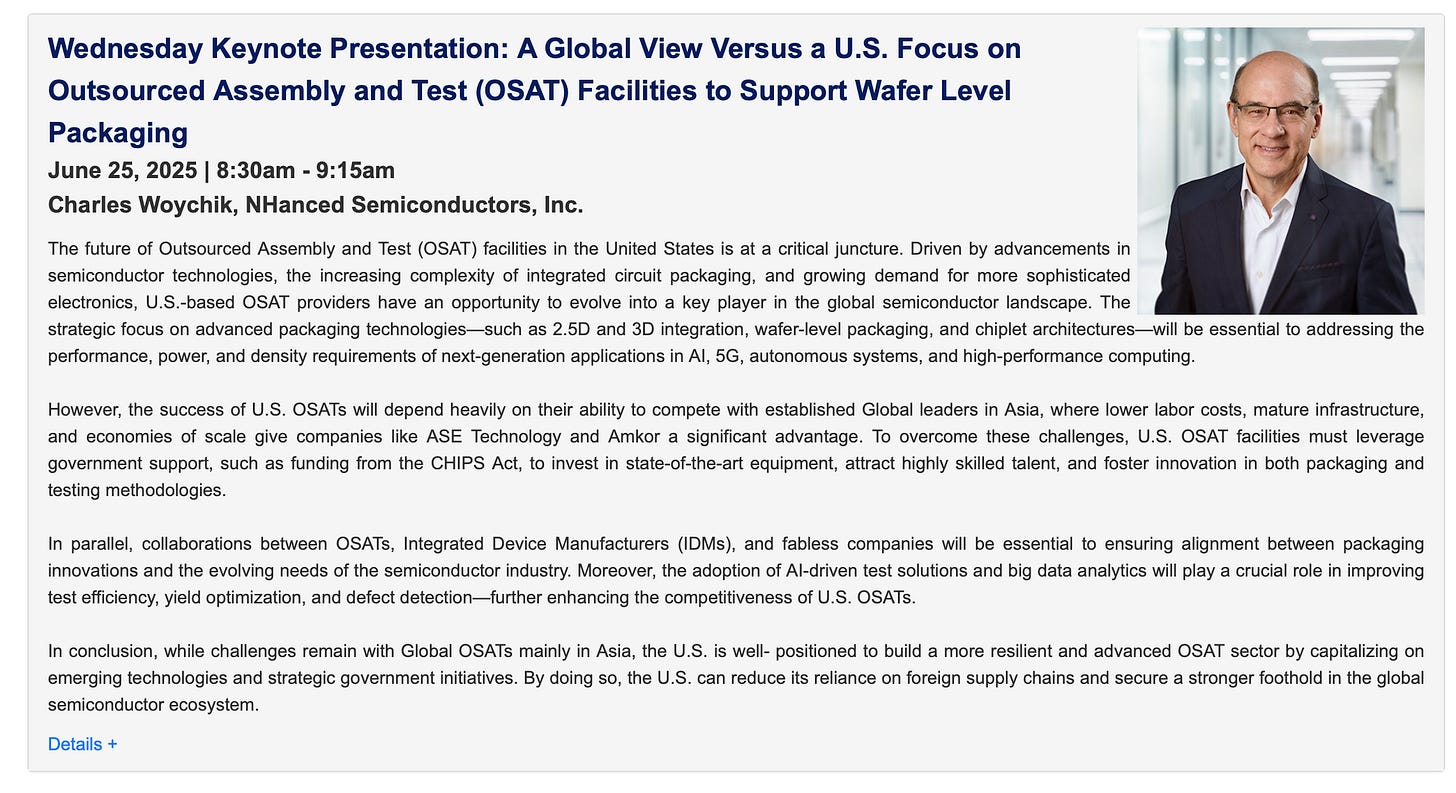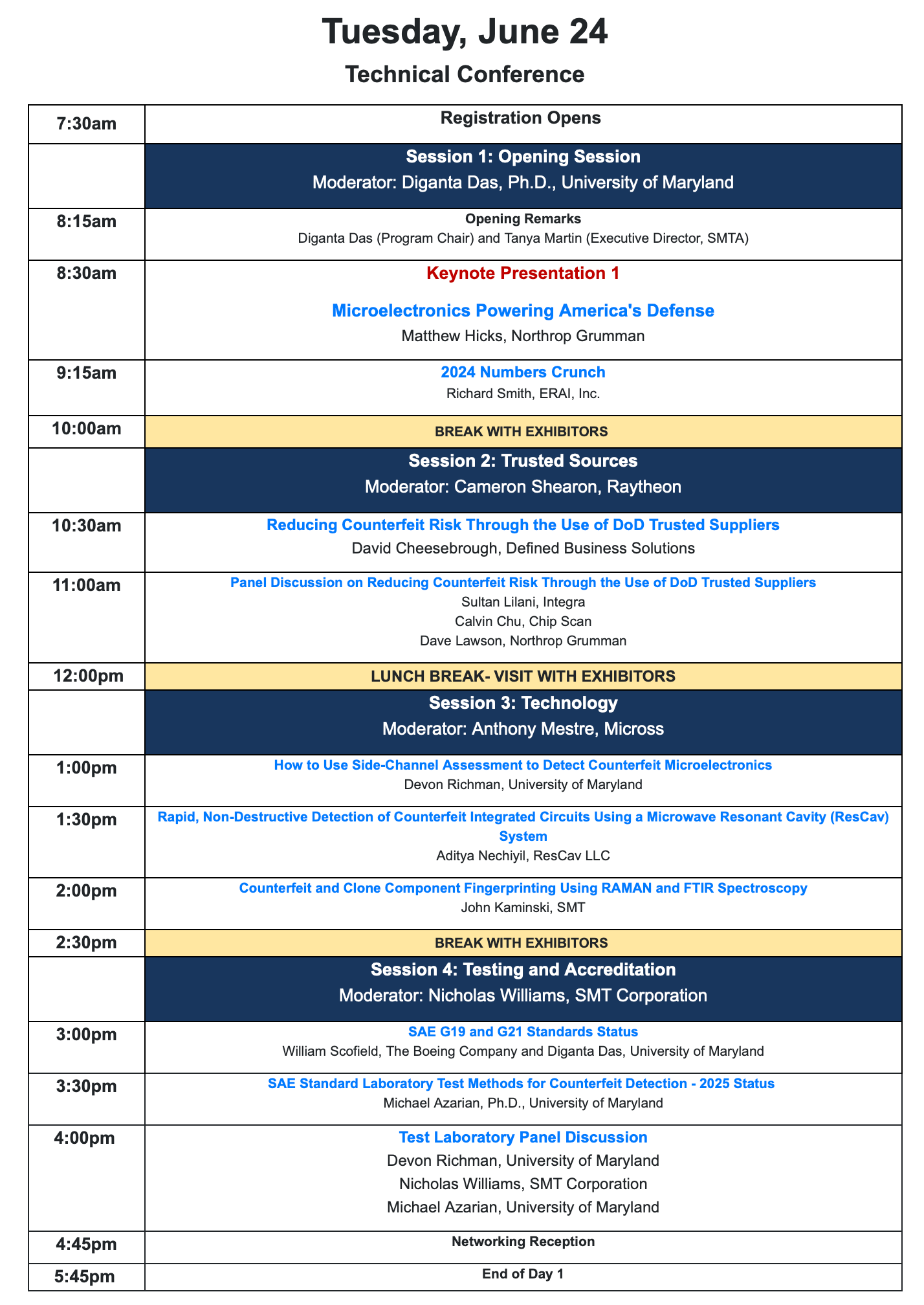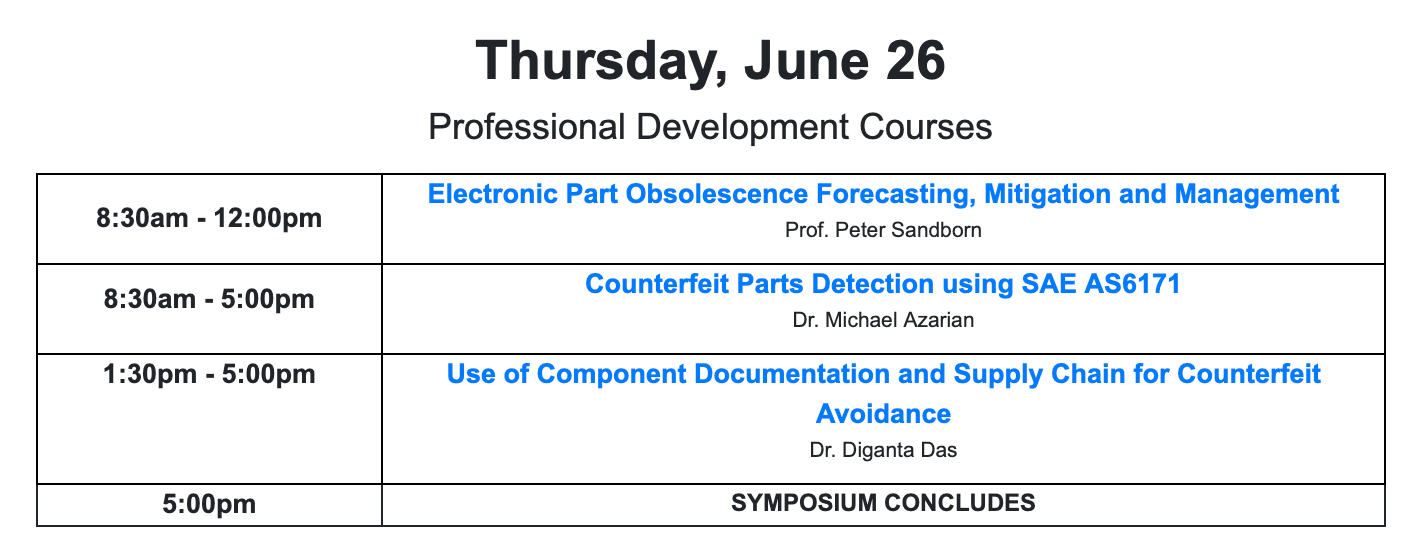SMTA Symposium 2025: Securing the Electronics Supply Chain with Advanced Packaging and Anti-Counterfeit Strategies
Original Articles By SemiVision Research (SMTA)
As global semiconductor supply chains face unprecedented challenges—from geopolitical tensions and counterfeit component threats to backend manufacturing imbalances—trust, traceability, and advanced packaging capabilities have become critical pillars of industry resilience. In response to these growing concerns, the 2025 SMTA Symposium on Counterfeit Parts & Materials will be held from June 24 to 26 in College Park, Maryland, jointly organized by the Surface Mount Technology Association (SMTA) and the Center for Advanced Life Cycle Engineering (CALCE)at the University of Maryland.
With the theme of “Building a Trusted, Traceable, and Strategically Autonomous Semiconductor Supply Chain,”this year’s symposium brings together leaders from defense, aerospace, semiconductors, and electronic test sectors. Through keynotes, technical sessions, and professional development workshops, the event will dive deep into topics such as anti-counterfeit strategies, advanced OSAT technologies, AI-driven testing, and blockchain-based traceability.
The opening keynote on June 24 will be delivered by Dr. Matthew Hicks of Northrup Grumman, titled “Microelectronics Powering America’s Defense.” Hicks will explore how microelectronics integration is transforming sensing, decision-making, and mission effectiveness across modern defense systems. He highlights the increasing reliance of the U.S. government on domestic semiconductor innovation to improve SWaP-C (Size, Weight, Power, and Cost) performance and calls for a secure, resilient component ecosystem to meet the demands of next-generation defense applications.
On June 25, Dr. Charles Woychik, Vice President of NHanced Semiconductors, will present the second keynote: “A Global View Versus a U.S. Focus on OSAT Facilities to Support Wafer-Level Packaging.” Woychik will argue that the U.S. OSAT industry stands at a pivotal inflection point—facing stiff competition from well-established Asian players like ASE and Amkor. He emphasizes the need for U.S. OSATs to leverage CHIPS Act funding, invest in cutting-edge wafer-level and 2.5D/3D integration technologies, and build domestic talent pipelines to reclaim competitiveness and reduce dependency on foreign backend capacity.
The multi-day program includes a variety of technical tracks—from AI-based counterfeit detection and DoD Trusted Supplier frameworks, to blockchain for traceability and AI-enabled test optimization. On June 26, three professional development courses will be held, led by academic and industry experts. Topics include electronic part obsolescence forecasting, SAE AS6171 counterfeit detection, and documentation and supply chain practices for anti-counterfeit assurance.
From national policy to lab-level innovation, and from test standards to packaging infrastructure, SMTA 2025 positions itself as more than just a symposium—it is a strategic forum for restoring trust and sovereignty to the electronics supply chain. For any organization participating in the global reshaping of semiconductor manufacturing, this event offers frontline insights and critical opportunities for alignment and collaboration.
SMTA Symposium on Counterfeit Parts & Materials: Strengthening Trust in the Electronics Supply Chain Through Advanced Packaging Innovation
As the global semiconductor supply chain becomes increasingly complex and diversified, the threats posed by counterfeit parts and non-compliant materials are escalating—especially for critical sectors such as defense, aerospace, communications, and advanced computing. In response, the SMTA Symposium on Counterfeit Parts & Materials, organized by the Surface Mount Technology Association (SMTA) in collaboration with the Center for Advanced Life Cycle Engineering (CALCE) at the University of Maryland, has emerged as North America’s leading technical forum for addressing counterfeit and high-risk components in the electronics supply chain.
Purpose and Core Topics
Since its inception, the symposium has focused on the mission to enhance supply chain transparency, reduce counterfeit risks, and promote industry-wide standards. Key discussion areas include:
Detection and authentication technologies for counterfeit electronics
Regulatory frameworks and compliance standards (e.g., AS5553, ISO/IEC)
Original component verification and traceability systems
Quality assurance for components in military and mission-critical systems
Materials engineering, forensic analysis, and risk assessment methodologies
Applications of AI, X-ray, optical, and material analytics in anti-counterfeit strategies
Strategic role of advanced packaging and test platforms in counterfeit prevention
Executive-Level Dialogues and Thought Leadership
Beyond a technical conference, the SMTA Symposium is a strategic crossroads for dialogue among policymakers, academic institutions, defense stakeholders, and industry leaders.
In the 2025 edition, Dr. Charles Woychik, Vice President of NHanced Semiconductors, will deliver a keynote address on how advanced packaging technologies—such as 2.5D, 3D-ICs, and chiplet integration—are redefining the competitiveness of U.S. OSAT companies. His talk will emphasize the need for leveraging CHIPS Act resources to bolster domestic capabilities in high-end packaging and manufacturing.
Why This Symposium Matters
With the rise of AI, high-frequency communication, and national security applications, the integrity and provenance of electronic components are now mission-critical. Questions like “Is this part authentic?”, “Is the source traceable?”, and “Is the test method validated?” dominate supply chain governance.
The SMTA Symposium delivers more than just presentations:
Interactive workshops
Policy and standards development roundtables
Hands-on insights from leading suppliers and verification labs
A platform for government-industry collaboration on actionable anti-counterfeit strategies
From Risk Detection to Resilient Design
As advanced packaging begins to replace traditional assembly models, embedding anti-counterfeit mechanisms, traceable markers, and reliability verification directly at the packaging stage will define the next evolution of the OSAT sector.
The SMTA Symposium offers a global platform for stakeholders to recognize this transformation, exchange insights, and take collaborative action.
For more information, please visit: https://smta.org/
NHanced Semiconductors VP Charles Woychik to Deliver Keynote at
SMTA’s Symposium on Counterfeit Parts & Materials in College Park, Maryland
Woychik’s address will highlight the critical role of advanced packaging technologies in the evolution of the U.S. OSAT industry to
effectively compete with global OSATs
Wednesday Keynote: A Global View vs. a U.S. Focus on OSAT – NHanced Semiconductors Charts the Future of Advanced Packaging
At the SMTA Symposium on Counterfeit Parts & Materials, Dr. Charles Woychik, Vice President of NHanced Semiconductors, Inc., will deliver a keynote address exploring the future of U.S. OSAT (Outsourced Assembly and Test) facilities and their strategic role in the evolving global semiconductor ecosystem.
Wednesday Keynote Presentation
Title: A Global View Versus a U.S. Focus on OSAT Facilities to Support Wafer Level Packaging
Date: June 25, 2025 | Time: 8:30am – 9:15am
Speaker: Charles Woychik, NHanced Semiconductors, Inc.
Keynote Overview
As the semiconductor industry moves into a new era of complexity—driven by 2.5D/3D integration, chiplet architectures, and wafer-level packaging—U.S.-based OSAT providers are presented with a rare opportunity to redefine their global relevance. Dr. Woychik will argue that advanced packaging is not just a technical enabler but a strategic differentiator for U.S. competitiveness in AI, 5G, autonomous systems, and high-performance computing.
However, the talk also outlines the significant challenges ahead. Global OSAT giants in Asia, such as ASE Technology and Amkor, benefit from lower labor costs, mature infrastructure, and economies of scale—factors that place U.S. players at a disadvantage. Overcoming this will require strategic investments, backed by initiatives like the CHIPS Act, to acquire cutting-edge equipment, attract specialized talent, and drive innovation across packaging and test.
Dr. Woychik will emphasize the need for cross-sector collaboration—between OSATs, IDMs, and fabless companies—to ensure that packaging innovations align with broader industry needs. He will also highlight how AI-driven test solutions and big data analytics are essential tools for boosting yield, accelerating defect detection, and improving test efficiency.
About NHanced Semiconductors
NHanced Semiconductors, Inc. is the world’s first pure-play advanced packaging foundry, headquartered in the United States. The company offers a unique business model known as Foundry 2.0, which integrates best-in-class chiplets and components sourced from traditional foundries using advanced packaging processes to create powerful, custom assemblies.
NHanced specializes in:
2.5D/3D IC integration
Wafer-level packaging
Silicon interposers and chiplet architectures
Photonic, microfluidic, and additive silicon technologies
With R&D and prototyping facilities near Research Triangle Park, NC, and advanced assembly operations in Indiana, NHanced is building the manufacturing infrastructure necessary to support the next generation of U.S.-based semiconductor innovation.
Why This Matters
The U.S. must reduce its dependency on foreign OSAT capacity and infrastructure, particularly as geopolitical risks increase.
NHanced Semiconductors presents a bold vision for how advanced packaging can re-anchor supply chain sovereignty in the U.S.
By investing in domestic capabilities and fostering innovation, the U.S. can regain a foothold in the global semiconductor backend ecosystem.
Microelectronics Powering America’s Defense: Northrup Grumman to Present at SMTA Symposium
At the upcoming SMTA Symposium on Counterfeit Parts & Materials, held on June 24, 2025, Matthew Hicksfrom Northrup Grumman will deliver a keynote address titled:
Tuesday Keynote Presentation:
Microelectronics Powering America’s Defense
Date: June 24, 2025 | Time: 8:30am – 9:15am
Speaker: Matthew Hicks, Northrup Grumman
Keynote Overview
Modern warfare increasingly depends on multi-functional microelectronics systems for sensing, processing, and decision-making across the electromagnetic spectrum. These technologies must be compact, secure, distributed, and capable of high-speed performance—driven by the need to detect diverse signal environments and ensure real-time situational awareness.
In his presentation, Hicks will explore how the U.S. Government (USG) is integrating domestic semiconductor technologies to meet dual-use mission requirements across both current and future platforms. As unmanned systems become more widespread, microelectronics integration is key to delivering performance enhancements and achieving defense objectives within strict SWaP-C (Size, Weight, Power, and Cost) constraints.
He will emphasize that:
The future of defense lies in ubiquitous sensors, edge computing, and real-time data analysis—all of which depend on a secure and resilient microelectronics supply chain to maintain national security and operational superiority.
About Northrup Grumman
Northrup Grumman Corporation is a leading global aerospace and defense technology company headquartered in Virginia, USA. The company provides advanced solutions for defense systems, space exploration, cyber security, missile defense, and electronic warfare, serving both the U.S. government and allied nations.
The company is a major contributor to fields such as microelectronics, sensor fusion, AI-driven edge processing, aerospace communications, and next-generation systems integration. Through strategic investments in research and development, Northrup Grumman plays a critical role in shaping the future of U.S. military capabilities.
In recent years, Northrup Grumman has also actively participated in government initiatives like the CHIPS Act, helping to rebuild and localize the domestic semiconductor supply chain—from chip design to advanced packaging—to safeguard the U.S.’s technological edge and national sovereignty.
Why This Matters
Amid growing geopolitical tension and supply chain uncertainty, the demand for trusted, sovereign microelectronics solutions has never been higher.
Microelectronics are no longer just an engineering challenge—they are now a strategic infrastructure for national defense.
Northrup Grumman demonstrates how advanced technology and industrial policy can be aligned to deliver defense systems that meet the performance, security, and mission-readiness demands of the future.
Media contact:
Chris Burke, BtB Marketing Communications(919) 637-3510
Professional Development Courses
Technical Conference
Please visit the official website for more information about this event.














